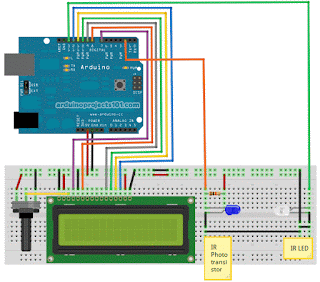Para isso monte sua pcb conforme está na figura:
Atente-se que nem sempre o display lcd vem na ordem exata de montagem. Se voce comprar o display lcd original pra arduino, ele vira nessa configuração, mas um "piratão" que foi o que eu usei, veio em outra configuração.
Aqui esta a configuração de um display original
Se voce ler nas entrelinhas que as posições sao invertidas, só brincar de batalha naval e "cruzar" as posições, caso contrario monte conforme esta desciminado na primeira imagem.
Bom, a parte de hardware montada e testado os sensores se acompanhou meu posta anterior, vamos ao que interessa :):):)
Este código eu removi de um site americano
-----
/* * Optical Tachometer * * Uses an IR LED and IR phototransistor to implement an optical tachometer. * The IR LED is connected to pin 13 and ran continually. * Pin 2 (interrupt 0) is connected across the IR detector. * * Code based on: www.instructables.com/id/Arduino-Based-Optical-Tachometer/ * Coded by: arduinoprojects101.com */ int ledPin = 13; // IR LED connected to digital pin 13 volatile byte rpmcount; unsigned int rpm; unsigned long timeold; // include the library code: #include <LiquidCrystal.h> // initialize the library with the numbers of the interface pins LiquidCrystal lcd(7, 8, 9, 10, 11, 12); void rpm_fun() { //Each rotation, this interrupt function is run twice, so take that into consideration for //calculating RPM //Update count rpmcount++; } void setup() { lcd.begin(16, 2); // intialise the LCD //Interrupt 0 is digital pin 2, so that is where the IR detector is connected //Triggers on FALLING (change from HIGH to LOW) attachInterrupt(0, rpm_fun, FALLING); //Turn on IR LED pinMode(ledPin, OUTPUT); digitalWrite(ledPin, HIGH); rpmcount = 0; rpm = 0; timeold = 0; } void loop() { //Update RPM every second delay(1000); //Don't process interrupts during calculations detachInterrupt(0); //Note that this would be 60*1000/(millis() - timeold)*rpmcount if the interrupt //happened once per revolution instead of twice. Other multiples could be used //for multi-bladed propellers or fans rpm = 30*1000/(millis() - timeold)*rpmcount; timeold = millis(); rpmcount = 0; //Print out result to lcd lcd.clear(); lcd.print("RPM="); lcd.print(rpm); //Restart the interrupt processing attachInterrupt(0, rpm_fun, FALLING); }-------------
E pelo meu vídeo ele funciona super bem.
Para montagem os leds emissor e receptor, 1 resistor de 10k ohms, um potenciometro de 10 k linear, um display lcd, um arduino e bastante fios para os jumpers, além das protoboards e um motorzinho pra testar e claro.
Em breve postarei o vídeo, aguardem...
Como prometido, eis o vídeo:


Nenhum comentário:
Postar um comentário